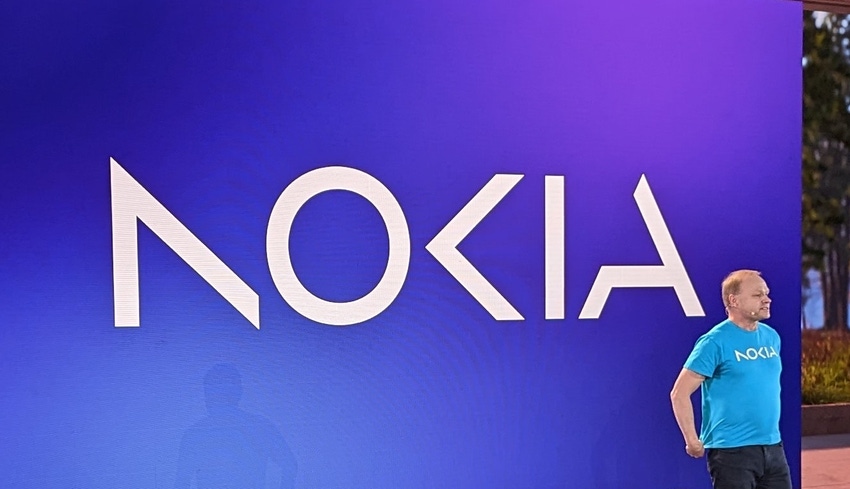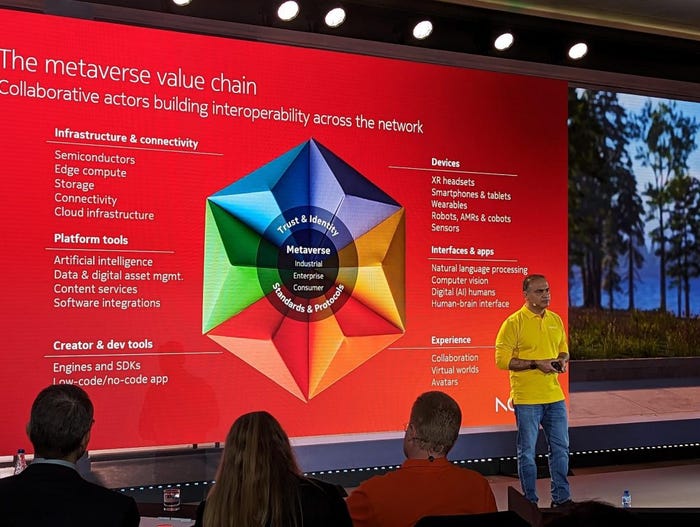Finnish kit vendor Nokia unveiled a new logo on the eve of Mobile World Congress 2023, but struggled to explain why.
February 26, 2023

Finnish kit vendor Nokia unveiled a new logo on the eve of Mobile World Congress 2023, but struggled to explain why.
Nokia held court in Intercontinental Hotel in Barcelona to unveil it’s new logo – or brand identity as marketing types would phrase it – the spirit of which is about severing ties with its consumer facing past (back when it used to sell phones) and to present a new one that’s apparently more reflective of its current B2B role. Alongside the new logo, Nokia presented an outline of how it expects networks to evolve in the next seven years or so, and how it is planning to evolve in line with these changes.
On stage at various points sketching out this vision was Pekka Lundmark, President and CEO of Nokia (pictured, top) and other senior execs who described 6 ‘pillars’ that they will be concentrating on to help them do this. These involve growing CSP business, expanding its share of enterprise business, actively manage its portfolio (whatever that means), ‘securing business longevity’ through Nokia Technologies, building new business models, and developing ESG (Environmental, Social and Governance) ‘into a competitive advantage.’
Presenting a vision of what it thinks the industry will be like by 2030, Chief Strategy and Technology Officer Nishant Batra (pictured below) emphasised how network technology is changing and intertwining with the cloud, and pointed to the ‘exponential potential of digital’ and ‘networks that think, sense and act.’ It said networks will increasingly be opened up and innovation with APIs will be significant. Open interfaces as they stand are ‘completely insufficient’ we were told, and it explained it’s aspiration of creating ‘network as a code’.
Nokia also and spoke a lot about the metaverse. Specifically it talked up the industrial and enterprise metaverse, which it says is growing much faster than the consumer metaverse, and spoke of ‘immersive collaboration’ and ‘physical industries being digitalised’. It went to far as to say that in the future network traffic will be dominated by XR or metaverse activity, not smartphone video as is currently the case.

“We see the potential of digital to transform business, industry and society with an opportunity for significant gains in productivity, sustainability and accessibility,” said Lundmark. “Our market-leading critical networking technology is increasingly needed by customers and partners in every industry. We see a future where networks go beyond connecting people and things. They’re adaptable, autonomous and consumable. They are networks that sense, think and act, and they maximize the opportunity of digitalization.
“Today we share our updated company and technology strategy with a focus on unleashing the exponential potential of networks – pioneering a future where networks meet cloud. To signal this ambition we are refreshing our brand to reflect who we are today – a B2B technology innovation leader. This is Nokia, but not as the world has seen us before.”
Rebranding is a funny old game. Its players like to associate all kinds of lofty, aspirational messaging with what is essentially a change of font, but what seemed so clear in the PowerPoint often fails to translate to the real world. It does makes sense to do it, though, if Nokia is concerned that every time it (or Ericsson for that matter) is mentioned to muggles outside of the telco sector, they probably still think of them as a phone brand. Incidentally the old brand will still live on HMD Global phones.
With regards to its grand vision – what we were presented with was a claim that the firm is pivoting towards new things in line with a changing technological landscape. The chief elements of this appeared to be an increased emphasis on cloud elements in networks, and of the future importance of APIs and opening the network up so other firms can get in and innovate somehow.
What it had in vision it lacked in specifics – there wasn’t much in terms of whether there were going to be any big changes structurally to enable it to pursue new and different business models, and when pressed on this at the Q and A section it didn’t really elaborate either. It’s vision of the future may turn out to be right, and its rival Ericsson would presumably also agree network APIs are going to be a big thing after its very expensive purchase of Vonage. But its apparent increased interest in the metaverse seems more of a punt. While they’ll be plenty of metaverse talk sloshing around MWC in the coming days, it remains an untested market so it’s always surprising to see firms go so heavy on it.
We do have some sympathy with Nokia execs and marketers, because the telecoms market in general is quite hard to explain these days. Take one of Nokia’s major product announcements at the show: anyRAN, which it describes as ‘a new concept to help mobile operators and enterprises extend their options for building and evolving their radio access networks.’
Here’s how Tommi Uitto, President of Mobile Networks at Nokia, described it in the press release. “The strength of our industry partnerships and the launch of anyRAN unlocks more choice and higher performance in Cloud RAN for our mobile network operator and enterprise customers. Server-based Cloud RAN will have to co-exist with purpose-built RAN in the short-to-medium term which calls for performance consistency and service continuity between the two.
“Together with our leading industry partners, we have made huge progress towards this goal by driving consistent performance across any partner’s Cloud Infrastructure or server hardware. Our collaborative approach to Cloud RAN means we can drive efficiency, innovation, openness, and scale by jointly delivering competitive advantage to organizations embracing Cloud RAN.”
That’s great, Tommi, but we’re still not sure what it does. The press release also offered commentary from Analyst Sue Rudd, of TechInsights (formerly Strategy Analytics) “As service providers evolve on the path towards disaggregated RAN, Nokia’s anyRAN offers them a solution with standard O-RAN fronthaul and 3GPP midhaul interfaces under seamless control that can operate across multiple Cloud partner data centers.
“Combined with acceleration from a new Layer 1 SMARTNIC and a ‘host neutral’ Container as a Service (CaaS) layer for DU and CU processing, this flexible open approach will allow operators to leverage Nokia’s powerful new ecosystem of platform and cloud partners to deliver very cost effective, high performance Cloud RAN service.”
See? Hard to explain. This year’s MWC is going to feature a lot of this kind of arcana as telecoms increasingly merges with the broader tech sector. The move to the cloud seems inevitable but the industry could still do a better job of explaining why. Maybe Nokia figured it would be easier to just have a rebrand instead but we’re still not sure exactly how new-look Nokia differs from the old one, apart from the logo.
Here’s the whole event and if you look carefully right at the start, in the middle of the picture you can see two intrepid Telecoms.com reporters beginning work on this very piece.
Get the latest news straight to your inbox. Register for the Telecoms.com newsletter here.
About the Author(s)
You May Also Like








.png?width=300&auto=webp&quality=80&disable=upscale)


_1.jpg?width=300&auto=webp&quality=80&disable=upscale)


.png?width=800&auto=webp&quality=80&disable=upscale)